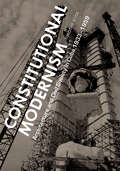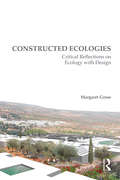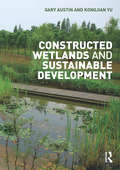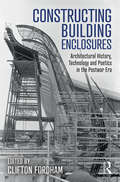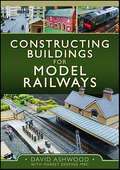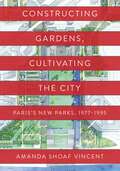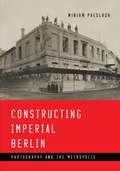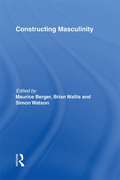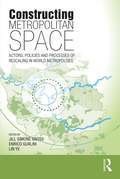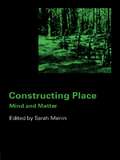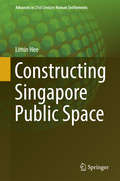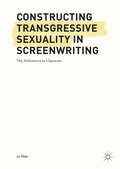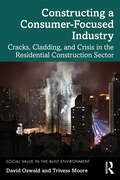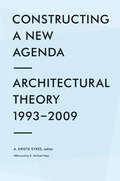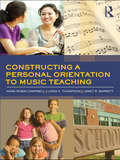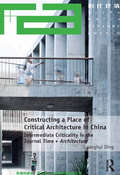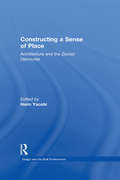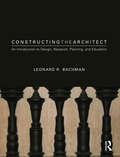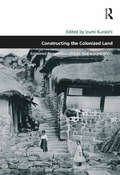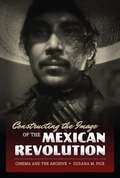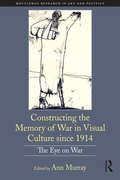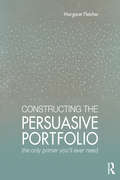- Table View
- List View
Constitutional Modernism: Architecture and Civil Society in Cuba, 1933-1959
by Timothy HydeHow does architecture make its appearance in civil society? Constitutional Modernism pursues this challenging question by exploring architecture, planning, and law as cultural forces. Analyzing the complex entanglements between these disciplines in the Cuban Republic, Timothy Hyde reveals how architects joined with other professionals and intellectuals in efforts to establish a stable civil society, from the promulgation of a new Cuban Constitution in 1940 up until the Cuban Revolution.By arguing that constitutionalism was elaborated through architectural principles and practices as well as legal ones, Hyde offers a new view of architectural modernism as a political and social instrument. He contends that constitutionalism produced a decisive confluence of law and architecture, a means for planning the future of Cuba. The importance of architecture in this process is laid bare by Hyde&’s thorough scrutiny of a variety of textual, graphical, and physical artifacts. He examines constitutional articles, exhibitions, interviews, master plans, monuments, and other primary materials as acts of design.Read from the perspective of architectural history, Constitutional Modernism demonstrates how the modernist concepts that developed as an international discourse before the Second World War evolved through interactions with other disciplines into a civil urbanism in Cuba. And read from the perspective of Cuban history, the book explains how not only material products such as buildings and monuments but also the immaterial methods of architecture as a cultural practice produced ideas that had consequential effects on the political circumstances of the nation.
Constructed Ecologies: Critical Reflections on Ecology with Design
by Margaret GroseToday, designers are shifting the practice of landscape architecture towards the need for a more complex understanding of ecological science. Constructed Ecologies presents ecology as critical theory for design, and provides major ideas for design that are supported with solid and imaginative science. In the questioning narrative of Constructed Ecologies, the author discards many old and tired theories in landscape architecture. With detailed documentation, she casts off the savannah theory, critiques the search for universals, reveals the needed role of designers in large-scale agriculture, abandons the overlay technique of McHarg, and introduces the ecological and urban health urgency of public night lighting. Margaret Grose presents wide-ranging new approaches and shows the importance of learning from science for design, of going beyond assumptions, of working in multiple rather than single issues, of disrupting linear design thinking, and of dealing with data. This book is written with a clear voice by an ecologist and landscape architect who has led design students into loving ecological science for the support it gives design.
Constructed Wetlands and Sustainable Development
by Gary Austin Kongjian YuThis book explains how with careful planning and design, the functions and performance of constructed wetlands can provide a huge range of benefits to humans and the environment. It documents the current designs and specifications for free water surface wetlands, horizontal and vertical subsurface flow wetlands, hybrid wetlands and bio retention basins; and explores how to plan, engineer, design and monitor these natural systems. Sections address resource management (landscape planning), technical issues (environmental engineering and botany), recreation and physical design (landscape architecture), and biological systems (ecology). Site and municipal scale strategies for flood management, storm-water treatment and green infrastructure are illustrated with case studies from the USA, Europe and China, which show how these principles have been put into practice. Written for upper level students and practitioners, this highly illustrated book provides designers with the tools they need to ensure constructed wetlands are sustainably created and well manage
Constructing Building Enclosures: Architectural History, Technology and Poetics in the Postwar Era
by Clifton FordhamConstructing Building Enclosures investigates and interrogates tensions that arose between the disciplines of architecture and engineering as they wrestled with technology and building cultures that evolved to deliver structures in the modern era. At the center of this history are inventive architects, engineers and projects that did not settle for conventional solutions, technologies and methods. Comprised of thirteen original essays by interdisciplinary scholars, this collection offers a critical look at the development and the purpose of building technology within a design framework. Through two distinct sections, the contributions first challenge notions of the boundaries between architecture, engineering and construction. The authors then investigate twentieth-century building projects, exploring technological and aesthetic boundaries of postwar modernism and uncovering lessons relevant to enclosure design that are typically overlooked. Projects include Louis Kahn’s Weiss House, Minoru Yamasaki’s Science Center, Sigurd Lewerentz’s Chapel of Hope and more. An important read for students, educators and researchers within architectural history, construction history, building technology and design, this volume sets out to disrupt common assumptions of how we understand this history.
Constructing Buildings for Model Railways
by David AshwoodAn illustrated demonstration of the construction process for different buildings to enhance your model railroad display. At some time during ownership a train set crosses an arbitrary threshold and becomes a model railway. The aspiring modeler then has the challenge of filling in all the gaps. Whether the line runs through the countryside, a village or town, some type of infrastructure is needed to represent the station, home, or factory. This can be a challenge to the modeler as there are a wide variety of offerings at differing price points and detail levels. This book progresses through planning and thought processes aiming to demonstrate pictorially several different build types. From the simple paper kit to mighty scratch-built edifices, each is broken down to show how the build is undertaken. This book also follows some of the rebuilding process undertaken by the Market Deeping Model Railway Club as layouts were repaired, enhanced, or replaced following their annual show being vandalized on the night before public opening in May 2019. As the news of this sad event broke, it went worldwide through the modeling community and public in general. The images of layouts broken to matchwood showed many years of skilled building and devoted operation which were lost. This gave the opportunity for experienced club members to build a mini movie set, construct a major London terminus and patch repair what could be saved from damaged originals. The photographic capture of these projects has been used within this book alongside the detailed work of other modelers, clubs, and societies.
Constructing Gardens, Cultivating the City: Paris’s New Parks, 1977-1995 (Penn Studies in Landscape Architecture)
by Amanda Shoaf VincentConstructing Gardens, Cultivating the City is the first cultural history of major new parks developed in Paris in the late twentieth century, as part of the city’s program of adaptive reuse of industrial spaces. Thanks to laws that gave the city more political autonomy, Paris’s local government launched a campaign of park creation in the late 1970s that continued to the turn of the millennium. The parks in this book represent this campaign and illustrate different facets of their cultural and historical context.Archival research, interviews, and analyses of the parks reveal how postmodern debates about urban planning, the historic city, public space, and nature’s presence in an urban setting influenced their designs. In sum, the city adopted the garden as a model for public parks, investing in complex, richly symbolic and representational spaces. These parks were intended to represent contemporary twists on traditional designs and serve local residents as much as they would contribute to Paris’s role as a world city.The parks’ development process often included points of conflict, pointing to differing views on what Parisian space should represent and fundamental contradictions between the characteristics of public space and the garden as it is traditionally defined. These parks demonstrate the ongoing cultivation of the city over time, in which transformed sites not only fulfil new functions but also engage with history and their surroundings to create new meaning. They stand for landscape as a form of signifying cultural production that directly engages with other art forms and ways of knowing. Just as the Luxembourg Gardens, the Tuileries, and the Buttes-Chaumont parks exemplify their eras’ cultural dynamics, such parks as the Jardin Atlantique, Parc André-Citroën, and the Jardin des Halles express contemporary French culture within the archetypal space of their era, the city. Finally, they point the way to current trends in landscape architecture, such as citizen gardening and ecological initiatives.
Constructing Imperial Berlin: Photography and the Metropolis
by Miriam PaeslackHow photography and a modernizing Berlin informed an urban image—and one another—in the late nineteenth and early twentieth centuries Since the fall of the Berlin Wall, the city that once visually epitomized a divided Europe has thrived in the international spotlight as an image of reunified statehood and urbanity. Yet research on Berlin&’s past has focused on the interwar years of the Weimar Republic or the Cold War era, with much less attention to the crucial Imperial years between 1871 and 1918. Constructing Imperial Berlin is the first book to critically assess, contextualize, and frame urban and architectural photographs of that era. Berlin, as it was pronounced Germany&’s capital in 1871, was fraught with questions that had previously beset Paris and London. How was urban expansion and transformation to be absorbed? What was the city&’s understanding of its comparably short history? Given this short history, how did it embody the idea of a capital? A key theme of this book is the close interrelation of the city&’s rapid physical metamorphosis with repercussions on promotional and critical narratives, the emergence of groundbreaking photographic technologies, and novel forms of mass distribution. Providing a rare analysis of this significant formative era, Miriam Paeslack shows a city far more complex than the common clichés as a historical and aspiring place suggest. Imperial Berlin emerges as a modern metropolis, only half-heartedly inhibited by urban preservationist concerns and rather more akin to North American cities in their bold industrialization and competing urban expansions than to European counterparts.
Constructing Masculinity
by Maurice Berger Simon Watson Brian WallisThis anthology takes us beyond the status of masculinity itself, questioning society's and the media's normative concepts of the masculine, and considering the extent to which men and women can transcend these stereotypes and prescriptions.
Constructing Metropolitan Space: Actors, Policies and Processes of Rescaling in World Metropolises
by Lin Ye Jill Simone Gross Enrico GualiniThere is little question today that processes of globalization affect national and local economies, governance processes, and conditions for economic competitiveness in the major urban regions of the world. In most liberal-democratic countries, these processes are occurring according to a rationale which attempts to combine strategies of state-supported development with increasing local-regional governmental decentralization and autonomy. Against this background, the issue of metropolitan development is being redefined worldwide, along with its institutional frameworks, modes of governance, policy instruments, and spatial planning strategies. The overarching assumption of this volume is that ‘metropolitan space’, far from being consolidated as a policy object, is currently being redefined and in some instances ‘constructed’ and contested as a scale, through a variety of policy practices related to spatial-economic development objectives. Through case studies drawn from across four continents, the authors reveal a range of interesting cross-national commonalities concerning the power that state actors, situated at various spatial scales, exert as agents in these processes. This volume interrogates key research issues raised by these developments, and is intended as a contribution to the establishment of a globally comparative analysis of the construction of metropolitan spaces and scales under conditions of globalization and neoliberalization.
Constructing Place: Mind and the Matter of Place-Making
by Sarah MeninThis book is a cutting edge study examining the attitudes to both nature and the built environment of the designer, the client and the society in which an intervention (be it architecture, landscape design or a piece of art) is made. The legacy of the Modernist view of nature and the environment is also addressed, and the degree to which such ideas continue to impinge on contemporary interventions is assessed.
Constructing Public Opinion: How Political Elites Do What They Like and Why We Seem to Go Along with It
by Justin LewisIs polling a process that brings "science" into the study of society? Or are polls crude instruments that tell us little about the way people actually think? The role of public opinion polls in government and mass media has gained increasing importance with each new election or poll taken. Here Lewis presents a new look at an old tradition, the first study of opinion polls using an interdisciplinary approach combining cultural studies, sociology, political science, and mass communication. Rather than dismissing polls, he considers them to be a significant form of representation in contemporary culture; he explores how the media report on polls and, in turn, how publicized results influence the way people respond to polls. Lewis argues that the media tend to exclude the more progressive side of popular opinion from public debate. While the media's influence is limited, it works strategically to maintain the power of pro-corporate political elites.
Constructing Singapore Public Space (Advances in 21st Century Human Settlements)
by Limin HeeThis book presents possible alternatives and interpretations to the well established notion in the mostly western discourse on public space. The discourse on public space as understood in the democratic-rationalist tradition, when applied to the Singaporean public space, would offer much criticism but would not be adequate in identifying alternative processes that allow for transformative potentials in public space. Thus said, the objectives of this book are: 1. To develop a conceptual frame of reference to construct the discourse on Singapore public space 2. To form a preliminary model of Singapore public space through analyzing case studies 3. To understand the modes, methods of production and representation of these public spaces within the rapidly changing urban context 4. To situate these constructions of public space and its possible trajectories within the larger discourse on public space, and to examine the viability of such a construction and interpretive model of public space
Constructing Suburbs: Competing Voices in a Debate over Urban Growth (Cities And Regions Ser. #Vol. 2)
by Ann ForsythExamining the debate between activists and professional planners over the vision of the future of a large growth corridor in Sydney, Australia, this case study maps the history of development from the late sixties to the mid-nineties, during which time serious environmental and financial problems arose. The book outlines five major visions of the future development and examines forms of political, economic, and institutional power applied by the parties in the project, with emphasis on the processes of infrastructure privatization and ecological impacts. The conclusion reflects on contemporary dilemmas about pluralism.
Constructing Transgressive Sexuality in Screenwriting: The Feiticeiro/a as Character
by Lj TheoThis book approaches the construction of complex and transgressive ‘pervert’ characters in mainstream (not ‘art’), adult-oriented (not pornographic) cinema. It deconstructs an episteme on which to base the construction of characters in screenplays, in a way that acknowledges how semiotic elements of characterisation intersect. In addition, it provides an extended re-phrasing of the notion of ‘the pervert’ as Feiticiero/a: a newly-coined construct that might serve as an underpinning for complex, sexual filmic characters that are both entertaining and challenging to audiences. This re-phrasing speaks to both an existential/phenomenological conception of personhood and to the scholarly tradition of the ‘linguistic turn’ of continental philosophers such as Foucault and Lacan, who represent language not primarily as describing the world but as constructing it. The result is an original and interdisciplinary volume that is brought to coherence through a queer, post-humanist lens.
Constructing a Consumer-Focused Industry: Cracks, Cladding and Crisis in the Residential Construction Sector (Social Value in the Built Environment)
by Trivess Moore David OswaldThe old saying ‘safe as houses’ is being challenged around the world like never before. Over recent decades homeowners have experienced the devastating effects of defects like asbestos, leaky buildings, structural failings, and more recently the combustible cladding crisis. The provision of safe and secure housing is a critical starting point to ensure that social value can be delivered in the built environment. However, some of these dangerous defects have resulted in a lack of security, safety, health, well-being, and social value for households and the wider community. The problems homeowners experience go beyond the substantial financial costs for defect rectification. Too often there has been a lack of government and industry support to help the housing consumer through these issues or to prevent them from occurring to begin with. It is time for a rethink and restructure of government policy, support, and industry practices to better protect housing consumers and deliver high-quality and sustainable housing that creates social value. Through evidence-based research and international case studies, this book focuses on the effects that dangerous defects have on the housing consumer. The ongoing construction cladding crisis is used as a primary case study throughout to highlight these implications, with other previous large-scale defect examples, such as leaky buildings and asbestos. Based upon the range of emerging evidence, we propose ideas for policy makers, construction and built environment professionals, owners corporations, and households on how to move forward towards a higher-quality, sustainable, and socially valuable way of residential living. Government policy has long focused on ‘making industry work’ through building regulations and standards. It is now time for greater government and industry focus on the consumer to make ‘consumer protection work’ in the built environment. There is a need to prevent dangerous defects like combustible cladding, better support consumers when defects emerge, and to create buildings for social value rather than minimum standards. Now is the time to build a better future for the end-user.
Constructing a New Agenda: Architectural Theory 1993-2009
by A. Krista Sykes K. Michael HaysThis follow-up to Kate Nesbitt's best-selling anthology Theorizing a New Agenda collects twenty-eight essays that address architecture theory from the mid-1990s, where Nesbitt left off, through the present. Kristin Sykes offers an overview of the myriad approaches and attitudes adopted by architects and architectural theorists during this era. Multiple themes—including the impact of digital technologies on processes of architectural design, production, materiality, and representation; the implications of globalization and networks of information; the growing emphasis on sustainable and green architecture; and the phenomenon of the 'starchitect' and iconic architecture—appear against a background colored by architectural theory, as it existed from the 1960s on, in a period of transition (if not crisis) that centers around the perceived abyss between theory and practice. Theory's transitional state persists today, rendering its immediate history particularly relevant to contemporary thought and practice.While other collections of recent theoretical writings exist none attempt to address the situation as a whole, providing in one place key theoretical texts of the past decade and a half. This book provides a foundation for ongoing discussions surrounding contemporary architectural thought and practice, with iconic essays by Greg Lynn, Deborah Berke, Sanford Kwinter, Samuel Mockbee, Stan Allen, Rem Koolhaas, William Mitchell, Anthony Vidler, Micahel Hays, Reinhold Martin, Reiser + Umemoto, Glenn Murcutt, William McDonough, Micahael Braungart, Michael Speaks, and many more.
Constructing a Personal Orientation to Music Teaching
by Mark Robin Campbell Linda K Thompson Janet R. BarrettConstructing a Personal Orientation to Music Teaching promotes inquiry and reflection to facilitate teacher growth, lifelong learning and a disposition toward educational change. Strongly grounded in current theories and research in teacher education, the text engages readers in analyzing their own experiences in order to conceptualize the complexity of teaching; involves them in clarifying their reasons for seeking a career in teaching; supports their insights, questions, and reflections about their work; and promotes a reflective, critical attitude about schools in general as teachers are urged to think of themselves as change agents in school settings.
Constructing a Place of Critical Architecture in China: Intermediate Criticality in the Journal Time + Architecture
by Guanghui DingFor the past 30 years, The Chinese journal Time + Architecture (Shidai Jianzhu) has focused on publishing innovative and exploratory work by emerging architects based in private design firms who were committed to new material, theoretical and pedagogical practices. In doing so, this book argues that the journal has engaged in the presentation and production of a particular form of critical architecture - described as an ’intermediate criticality’ - as a response to the particular constraints of the Chinese cultural and political context. The journal’s publications displayed a ’dual critique’ - a resistant attitude to the dominant modes of commercial building practice, characterised by rapid and large-scale urban expansion, and an alternative publishing practice focusing on emerging, independent architectural practitioners through the active integration of theoretical debates, architectural projects, and criticisms. This dual critique is illustrated through a careful review and analysis of the history and programme of the journal. By showing how the work of emerging architects, including Yung Ho Chang, Wang Shu, Liu Jiakun and Urbanus, are situated within the context of the journal’s special thematic editions on experimental architecture, exhibition, group design, new urban space and professional system, the book assesses the contribution the journal has made to the emergence of a critical architecture in China, in the context of how it was articulated, debated, presented and perhaps even ’produced’ within the pages of the publication itself. The protagonists of critical architecture have endeavoured to construct an alternative mode of form and space with strong aesthetic and socio-political implications to the predominant production of architecture under the current Chinese socialist market economy. To rebel against certain forms of domination and suppression by capital and power is by no means to completely reject them; rather, it is to use thos
Constructing a Sense of Place: Architecture and the Zionist Discourse (Design and the Built Environment)
by Haim YacobiWhile it is widely recognized that architects and their architecture play a key role in constructing a sense of place, the inherent nexus between an architectural ideology and the production of national space and place has so far been neglected. Focusing on the Zionist ideology, this book brings together practising architects and academics to critically examine the role of architects, architecture and spatial practices as mediators between national ideology and the politicization of space. The book first of all sets out the wider context of theoretical debates concerning the role of architecture in the process of constructing a sense of place then divides into six main sections. The book not only provides an innovative new perspective on how the Israeli state had developed, but also sheds light on how architecture shapes national identity in any post-colonial and settler state.
Constructing the Architect: An Introduction To Design, Research, Planning, And Education
by Leonard R. BachmanUnlike books that concentrate on the monuments and other artefacts that architects produce, Constructing the Architect focuses on architecture as a disciplinary and professional process, an institution of society, and a career of learning and mastery. In doing so, it offers a lens into the architecture of architecture. Mapping architecture as a coherent whole, Leonard Bachman shows that the field must be understood as four mutually reinforcing modes of inquiry: design, research, strategy, and education. Within this framework, he explains how institutions and actors hold differing perspectives on the critical discourse that advances architecture and identifies the various tensions and leverage points for change within the discipline. Featuring over 100 illustrations to support understanding of this highly visual subject, this is an essential introduction for any student seeking to understand what it means to be an architect and to enter the professional discourse.
Constructing the Colonized Land: Entwined Perspectives of East Asia around WWII (Design And The Built Environment Ser.)
by Izumi KuroishiDespite the precipitous rise of East Asia as a center of architectural production since the Second World War, informed studies remain lacking. The lacuna is particularly conspicuous in terms of regional, cross-national studies, documenting the close ties and parallels between China, Taiwan, Japan and Korea during this period. Examining colonized cities in East Asia, this book brings together a range of different perspectives across both space and time. European, Chinese, Taiwanese, Korean and Japanese discourses are examined, with a range of complementary and conflicting views on the design of urban and architectural forms; the political, institutional, religious and economical contexts of urban planning; the role played by various media; and the influence of various geographical, social and anthropological research methods. The diversity and plurality of these perspectives in this book provides an entwined architectural, urban and social history of East Asia, which offers insights into the cultural systems and the historical and spatial meanings of these colonized cities. It concludes that the difficulties in the historical study of East Asia's colonial cities do not so much indicate cultural difference as the potentiality for multiple readings of the past toward the future.
Constructing the Image of the Mexican Revolution
by Zuzana M. PickWith a cast ranging from Pancho Villa to Dolores del Río and Tina Modotti, Constructing the Image of the Mexican Revolution demonstrates the crucial role played by Mexican and foreign visual artists in revolutionizing Mexico's twentieth-century national iconography. Investigating the convergence of cinema, photography, painting, and other graphic arts in this process, Zuzana Pick illuminates how the Mexican Revolution's timeline (1910-1917) corresponds with the emergence of media culture and modernity. Drawing on twelve foundational films from Que Viva Mexico! (1931-1932) to And Starring Pancho Villa as Himself (2003), Pick proposes that cinematic images reflect the image repertoire produced during the revolution, often playing on existing nationalist themes or on folkloric motifs designed for export. Ultimately illustrating the ways in which modernism reinvented existing signifiers of national identity, Constructing the Image of the Mexican Revolution unites historicity, aesthetics, and narrative to enrich our understanding of Mexicanidad.
Constructing the Memory of War in Visual Culture since 1914: The Eye on War (Routledge Research in Art and Politics)
by Ann MurrayThis collection provides a transnational, interdisciplinary perspective on artistic responses to war from 1914 to the present, analysing a broad selection of the rich, complex body of work which has emerged in response to conflicts since the Great War. Many of the creators examined here embody the human experience of war: first-hand witnesses who developed a unique visual language in direct response to their role as victim, soldier, refugee, resister, prisoner and embedded or official artist. Contributors address specific issues relating to propaganda, wartime femininity and masculinity, women as war artists, trauma, the role of art in soldiery, memory, art as resistance, identity and the memorialisation of war.
Constructing the Persuasive Portfolio: The Only Primer You’ll Ever Need
by Margaret FletcherConstructing the Persuasive Portfolio helps you learn the art of designing a compelling and effective architectural portfolio. Margaret Fletcher categorizes the architectural portfolio design process into a step-by-step method that you can manage and understand. The full-color book includes 400 portfolio examples from 55 designers, along with more than 50 diagrams, and a set of 48 design actions that are marked throughout. You will learn how to:-Identify your readership-Collect, document, and catalog your work-Organize your portfolio-Visually structure your portfolio-Design your layout-Manage both printed and digital portfolio formats As your ultimate persuasive tool, your portfolio is the single most important design exercise of your academic and professional career. Constructing the Persuasive Portfolio shows you everything you need to know to create your portfolio and is the only portfolio design book you will ever need!
